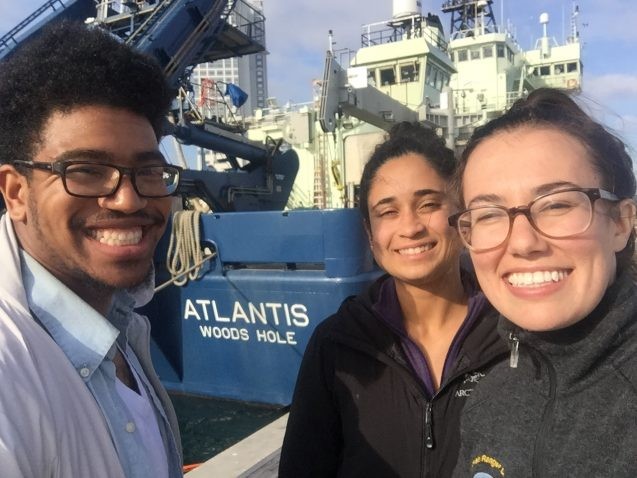STEMSEAS: Not Just an Internship, An Adventure
The seagoing expedition program designed to bring diversity to the geosciences goes virtual.

Este artículo ha sido adaptado en español aquí.
This spring, the latest cohort of the Science Technology Engineering and Math Student Experiences Aboard Ships program (STEMSEAS) was preparing to set sail. The plan was to board the R/V Endeavor in Fort Lauderdale, Florida, and travel up to Narragansett in Rhode Island, teaching the students about field research along the way. Ten students and three instructors/mentors were ready to go. But in April, the COVID-19 pandemic put the expedition and all STEMSEAS missions on hold—a huge disappointment but not a complete deal-breaker.
“It took me a long time to accept it,” said Sharon Cooper, the co-principal investigator of STEMSEAS and marine education officer at Columbia University’s Lamont-Doherty Earth Observatory. When Cooper and her colleagues came to terms with the inevitable new restrictions, they developed a plan to create virtual STEMSEAS experiences as a way to keep their student applicants engaged. The strategy is built around connecting students during live webcasts with the select few scientists now permitted to sail during the pandemic.
“This is the best we can do, and we hope it is of value — virtual events with expeditions that are going out, and [connecting students] with scientists, mentors, and graduate students both on shore and at sea. We’re trying to create the mentor value and networking as much as we can,” said Cooper.
The program, which began in 2016 and is a partnership between the Indiana University of Pennsylvania, Lamont and the University-National Oceanographic Laboratory System (UNOLS), has an urgent mission; increasing diversity in the notoriously “white” geosciences by opening the world of seagoing research to deserving undergraduates.
Cooper says the idea for STEMSEAS came with recognition of an underutilized aspect of the UNOLS research cruises. The organization is made up of a group of U.S. academic institutions and national laboratories organized to coordinate research vessels for federally funded ocean research. Typically, each year, more than a dozen of these cruise ships crisscross the world for scientific exploration. However, the “transits,” the repositioning of the ships between cruises, were open and, in Cooper’s estimation, a great untapped opportunity for learning.
“In the past those transits were mostly empty, but that ship time is already paid for by NSF and individual grants,” said Cooper. She and co-PI Jonathan Lewis realized if they could get undergraduates onboard those transits, they would be leveraging existing resources to create mini-expeditions for underrepresented groups of students and hopefully opening up a world of possibility to them.
Cooper and colleagues made their case, secured NSF funding, and began opening seagoing exploration to new groups of future geoscientists.
STEMSEAS students pay nothing and spend from five to ten days at sea. In order to select students from diverse racial, ethnic, and economic backgrounds, organizers reach out to community colleges and other institutions to find students who wouldn’t otherwise have this opportunity.
“We try to reach a diversity of kinds of institutions to recruit a diversity of students. We also try to go after first-generation college students,” said Cooper. ”[The program] gives the student a chance to experience research at sea and all the different aspects of that. Including everything the crew does, the captain, the technicians, everybody. They get exposure to all of that.”

While it’s too early to tell if STEMSEAS is having a measurable impact on diversity in the geosciences—so far 126 students have participated—anecdotal reporting suggests STEMSEAS is capturing hearts and minds.
Elizabeth Newman was among the first STEMSEAS cohort in August of 2016. They traveled aboard the R/V Sikuliaq and sailed from Seattle, Washington to Seward, Alaska. Newman later participated in another seagoing research project as research assistant.
“[STEMSEAS] pushed me to find and participate in as many field experiences as I could. Now I’m about to become an elementary school teacher,” said Newman. “STEMSEAS encourages students from community colleges, four-year schools, all majors, all backgrounds to apply. They are centered around diversifying the geoscience field and creating an inclusive community. As I prepare to go into my first year of teaching, I am using my experience with STEMSEAS as a sort of model of what an inclusive learning environment and equity-driven classroom community could look like.”
“Most students don’t know about a lot of these topics and these possible careers,” said Cooper. “Then they get super excited. That’s really inspiring. It’s what we wanted and to actually see it happen, and to see them take advantage of those opportunities, is great.”
Cooper hopes next year STEMSEAS can once again bring deserving students a chance to sail and experience seagoing research … on ships rather than on screens.
